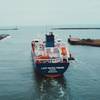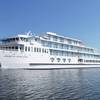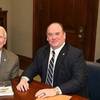The Tillberg name is synonymous with luxurious cruise ship design, often serving as the masterminds in the creation of images and themes that will capture the essence of the each vessel's itinerary and passenger base. MR/EN spoke with two generations of the Tillbergs — founder Robert — and son Tomas — to discuss their philosophies, ideas and creations for a business that is expediently working to meet the cruise industry's newbuild boom.
From the time he was a young man attending college in Sweden, Tomas Tillberg longed for the day that he could join his father, Robert Tillberg, at work designing and dreaming up new ideas for the cruise ship industry. Tomas remembers wanting to accompany his father on his daily routine — whether it was a meeting at a European shipyard with engineers or at his father's home base at his design firm in Viken, Sweden — Tomas wanted to be a part of the industry that has helped to establish Tillberg Design into the "family" of cruise ship designers/engineers. As much as the younger Tillberg wanted to free his creative mind within the world of cruise ship designing, at that time, little did he know that one day he would go on to head the U.S. branch of his father's company during one of the most groundbreaking moments in the cruise industry — the construction of the first cruise ships in the U.S. in 40 years.
Tillberg Design has earned the title as one of the two firms working to design the two newbuilds that have been ordered for American Classic Voyages' (AMCV) new United States Lines. The two vessels, which are currently being built by Litton Ingalls Shipbuilding in Pascagoula, Miss. will be homeported in Honolulu, Hawaii for weekly cruises throughout the Hawaiian Islands. Originally supposed to have been constructed by NASSCO, AMCV chose Litton Ingalls to build the two ships, whose first steel was just recently cut. Since the Norwegian firm of Yran and Storbraaten had already been tapped by Ingalls to perform the architectural design of the vessel pair, the firm was signed on with Tillberg as a joint effort since AMCV had a strong belief that the Tillbergs could effectively capture the sense of a surreal Hawaiian atmosphere — and why not, when after all, the Tillberg team swears by two basic criteria before designing a ship — itinerary and passenger.
In fact, Tomas added that AMCV invited the Tillberg architects that were assigned to the project to step onboard AMCV-owned (American Hawaii's) S.S. Independence to grab hold of the Hawaiian essence (the vessel currently operates cruises to the Hawaiian Islands for the line).
"Project America (U.S. Lines) is specifically geared toward Hawaii/American patriotism," Tomas said. "We try not to do a pastiche or rather, looking glass feel, we want to capture the real thing — rather than just providing a take on it."
Just what is Hawaiian design and how is the Tillberg team going to provide the "real thing?" According to both Tomas and Robert, there's a certain heritage that Hawaii possesses — it's different from the Caribbean, not just by its landscape, but the fact that it boasts natural wonders as rain forests and volcanoes. In addition, unlike the Caribbean, the weather patterns are different allowing the option for the design of an outdoor eating area on the ship.
As lead designer on the project, Tomas is modest to credit one specific person who assisted the firm in "capturing the Hawaiian essence" on the vessels — Mary Philpotts of Honolulu-based Philpotts and Associates. A Hawaiian native, Philpotts was hired by AMCV to provide Tillberg with her knowledge and ideas of what represents Hawaiian design, and to assist Marcello Moino of the firm's Fort Lauderdale office with the design of the vessels' atriums. Moino, who is the lead designer on this specific area, worked with Philpotts on this public area to grasp the crux of Hawaiian culture through design.
The Commencement Of A Legacy
Growing up along the coastal town of Vasterik, Sweden, Robert first aspired to devote his talents as a landscape artist, but these thoughts were squandered when after comparing his work to that of others, Robert felt he could not measure up — thus leading him to set his sights on something more fruitful — specifically in the league of furniture design.
Deciding to leave the small haven of Vasterik to study architecture and furniture design in Stockholm was most likely Robert's gift to the cruise industry, as it was there where he began to shape his craft. While in Stockholm, he developed his talents within the areas of cabinet making, upholstery, fabrics and textiles, which most likely lended a hand in the evolution of his now-illustrious career. Robert concluded his formal education — which also allowed him to study with Swedish furniture designer Carl Malmsten — earning the titles of qualified architect and furniture designer. Shortly after, Robert landed a job with G.A. Berg — a Gothenburg company that concentrated on ships' furnishings. G.A. Berg prepared Robert for what would plant the seeds for his eventual status —as it was there that he began designing and creating furniture for ships — a career that would carry him throughout the 1940s and 1950s — and would include the outfitting of vessels such as the North Sea passenger ferry SAGA.
In 1964, Tillberg entered the cruise design arena on his own by garnering the contract as lead designer on Swedish American Line's Kungsholm. The vessel, which ironically was built in the same yard as Cunard's QEII, preceded two vessels, which undoubtedly hold special places in Robert's heart, as they were the newbuilds that most likely allowed Robert to find his niche within the cruise ship design industry. The vessels, Sea Venture and Island Venture included a series of special chairs used in the vessels' lounges and dining areas. These "comfortable, easy chairs," were designed by one of the only two original Tillberg designers who are still with the firm — Walter Moller.
Described by Robert as a "very good designer of furniture," Moller, who has been loyal to the firm for more than 30 years, still contributes his creativity to different Tillberg projects. Robert credits part two of his lifers as Anders Johansson who, like Moller has been with the firm for 30+ years. Although he is on the edge of retirement, Johansson operates out of the Swedish office, maintaining and establishing the relationships that he has had with the various European shipyards over the years. Johannsson is a gifted asset to the firm because of his technical background and experience in dealing with shipyard engineers — a talent that, according to both Tillbergs is a necessity.
"It's an important part of our jobs to have good relationships/operations with the yards," Tomas Tillberg interjected.
This is most likely the reason for the locale of Tillberg's European offices, since the four major cruise ship yards are based in Finland, Italy, France and Germany — allowing Tillberg to split the work between his London and Viken outlets, which also provide a fairly easy airplane commutation on occasions when Robert must join his son at the Florida office. With the Tillberg style having grown in Europe, the American operation was not far behind. According to Tomas, the company opened its Florida operation in 1999 with 1.5 floors, and recently purchased an additional floor to accommodate the hiring of additional designers.
Tomas, as well as Robert, felt that the need for a U.S.-based operation was imminent not merely because most of the major playing cruise lines are headquartered in South Florida, but also many U.S-based suppliers are now entering into the cruise shipping game — mostly due to the recent boom of U.S.-based cruise shipbuilding. Tomas felt the best way to reach these new potential clients would be to establish ties that were closer to them. U.S.-based suppliers may one day even become so competitive in the cruise-shipping arena that they will outnumber the already-established European manufacturers.
"The resources and possibilities are astounding for cruise companies," Tomas said. "They (cruise lines) will want to stay with American suppliers."
In fact, some of the European based companies have followed Tillberg Design's strategy by establishing U.S.-based offices of their own. One example is Brinton — a U.K.-based carpet manufacturer, which purchased a full carpet mill in the Southeastern U.S. for carpet production, undoubtedly to be closer to the cruise ship owners and the U.S.-based shipyards — many of which are located in the Southern part of the U.S.
Passing the Torch
Like his father, Tomas completed his formal education in Stockholm, but chose to venture off more towards painting, sculpting and art history, rather than furniture construction — at one time, he shared that he even desired to make his living as a painter.
Upon graduating from Stockholm's Academy of Arts, Tomas ventured to the travel and tourism business, beginning his career at a Swedish engineering company setting up contracts for renovations of luxury hotels throughout Europe. While it wasn't what he had initially desired, which was designing ships with his father, the position allowed Tomas to gain experience on both sides of the operation— even if it was for land-based entities, rather than the floating hotels known as cruise ships.
"I have thorough experience on both sides of the business (creating and running)," Tomas said. This allows me to understand the business from an artist's perspective, and from a contracting perspective when dealing with yard engineers."
It was approximately five-and-a-half years ago, that Tomas' dream of being able to collaborate with his father became a reality, when it was decided by both Robert and the firm's managing director, Lennart Ekstedt, that a U.S. presence was imminent to allow Tillberg Design to fully embrace their new U.S. shipbuilding projects such as the new "floating trade show" ship being constructed for Sea America. The vessel, which is scheduled for a 2003 delivery, will be able to accommodate 1,800 passengers, who are traveling for both business and pleasure purposes. The company has completed the majority of the vessel's basic designs, which were delivered to the builder, Litton Ingalls, on August 11. Headed by Tomas, with Jean-Louis Stutzmann as project manager, the Sea America design team was comprised of a mixture of American and European designers based in the Fort Lauderdale office. The vessel's theme, which according to Tomas rests on the firm's passenger/itinerary basis, is geared toward a professional, who enjoys mixing business with pleasure.
New Companies Seeking Themes
Tillberg Design has fastidiously made a name for itself within the internationally based cruise companies that have taken the market by storm in the last six years. New companies such as Crystal Cruises and Star Cruises — wanted to create a product that was fresh — and they wanted Tillberg Design to help them formulate an image that would grab potential passengers' interest.
The 1990's also marked the beginning of the Crystal Cruise Lines project. The vessel pair Harmony and Symphony, which were constructed at Mitsubishi Heavy Industries (MHI), and Kvaerner Masa-Turku, respectively for Crystal's owner — Japanese Shipping Company Nippon Yusun Kaisha (NYK) — allowed the Tillberg team to get its feet wet for an additional project that would await them — an exclusive contract with Malaysian-based Star Cruises for the design of all newbuilds. Since the line wanted to market itself as touting non-Caribbean and European itineraries to the up-and-coming Asian customer base — rather than the traditional Caribbean or European excursions typically geared toward the American or European cruiser — Tillberg focused on designs that would present multiple themes with Asian influences on Star's premiere vessel Superstar Leo.
Similar to the U.S. Lines project, Tillberg went a step further in trying to capture the Asian culture by having its designers travel to Kuala Lumpur and Hong Kong to then emulate the atmosphere of these locales into Star's vessels.
Back in the U.S., Tillberg faced another challenge with Celebration, Fla.-based Disney Cruise Lines, who was a new cruise line, but unlike Crystal and Star — already had in mind the type of product they wanted Tillberg to take from paper to reality. Although the firm designed only the staterooms and the Palo Restaurant on Disney's Magic and Wonder, Tomas notes that it was probably one of the most challenging projects undertaken by the firm.
"Disney was unusual because it was almost like entering another world," he said. "Even though they were a new cruise ship builder, it was unusual that they knew exactly what they wanted and had specific ideas."
The Tillberg creativity was put to the test on this project, but the firm came through in stellar form for Disney. Tillberg even managed to create a new innovation on the Disney ships that had never before been implemented on a cruise ship — a split bathroom in the family cabins and outside standard cabins. These special bathrooms hold a bathtub, shower and sink in one room — attached to an adjoining room with a toilet and sink, thus enabling one person to use the toilet or wash their hands, while the other person can shower privately. Tillberg thought that since Disney has a reputation of attracting family vacationers that this design would be most conducive.
Melding Tradition With Technology
Presently, Tillberg Design is mixing tradition while still focusing on the development of possible futuristic designs. The firm has been signed on as the lead designer for the $600 million, 1,131 ft. (345 m) Queen Mary 2. Scheduled for delivery in 2003, the 2,800-passenger vessel, which will be constructed by Chantiers de l' Atlantique, is being touted as the world's largest cruise ship ever built. While Tomas and Robert are not at liberty to discuss the project's specifics, the vessel's design will lean towards "the thrill of the classic oceanliner — or the big sister to QEII."
"The Queen Mary 2 will be built to handle the severe weather of the North Atlantic," Tomas said. "The front will have a strong, long, narrow bow stretched to the front of the ship, while the front end of the superstructure will be able to handle an Atlantic storm at 28 knots."
Since the letter of intent between Carnival Corp.-owned Cunard and Chantiers occurred in March, Tillberg Design has been assisted by Cunard's senior executives, Larry Pimentel, president; and Pamela Connover, COO, as well as Carnival's technical team in London led by senior naval architect Stephen Payne to develop preliminary designs that will capture the dream of a luxury liner.
According to Robert, the designs of the White Star Line era were actually considered forward thinking of that time — employing an even further sense of heightened technology and engineering beneath Queen Mary 2's bowels.
In an age of the new millennium, where gas turbines are becoming all the rage in the cruise industry, and owners are requiring quicker construction turnaround times, Tillberg Design is focused on rolling with the trends of the industry that sometimes change on a daily basis.
Continuing to employ its expansion efforts with added designers to meet the bottom lines set out by cruise owners, the company has gone beyond the current trends with the development of some futuristic design on their drawing tables. Although these images have not yet been adopted and/or bought by cruise owners, new technology enables designers to create images such as these so that when owners are ready to embrace the future, Tillberg Design will be fast to meet their needs.
"The idea we have developed is to present a very fast, sleek looking ship to owners," Tomas said. "But," he cautioned, "If you have to step too far into the future, you step out of practicality."
The practicality that Tomas is referring to is lack of funds, as these technologically driven designs could end up costing owners more than what can fit into their budgets.
However, though, Tomas predicts that eventually evolution will occur and owners will want to implement these futuristic creations.
"If there's hesitation that it wouldn't work, then it (the ship) doesn't get built," Tomas said. "There has to be an evolution — maybe someone will be interested — perhaps in possibly five to ten years."
Subscribe for
Maritime Reporter E-News
Maritime Reporter E-News is the maritime industry's largest circulation and most authoritative ENews Service, delivered to your Email five times per week













